When Chloe Tatton boarded a flight to relocate to Dubai early last year, she hoped the change of climate might help ease her skin problems. At 25, she was excited for a fresh start with her partner Matthew, then 26, a financial planner.
But instead of bringing relief, the move became a medical nightmare, leaving her bedridden and eventually hospitalised with a potentially life-threatening skin condition.
Soon after taking her seat on the plane, Chloe smoothed moisturiser onto her face to stop the air onboard drying it out.
But just two hours in, her skin began burning up. When she went to the bathroom, she was horrified to see her whole face and neck were red and raw.
By the time the plane landed, she was ‘in absolute agony’.
And her symptoms got progressively worse over the next few weeks: ‘The raw skin on my face, limbs and body was breaking down, weeping and peeling off. I couldn’t get out of bed.’
Chloe was experiencing topical steroid withdrawal (TSW), which can occur after people stop taking corticosteroid creams after prolonged use.
Corticosteroid creams, or topical steroids, are used to control dermatitis and many other inflammatory skin conditions – they work by reducing inflammation and irritation and are recommended by the NHS for treating eczema flare-ups.
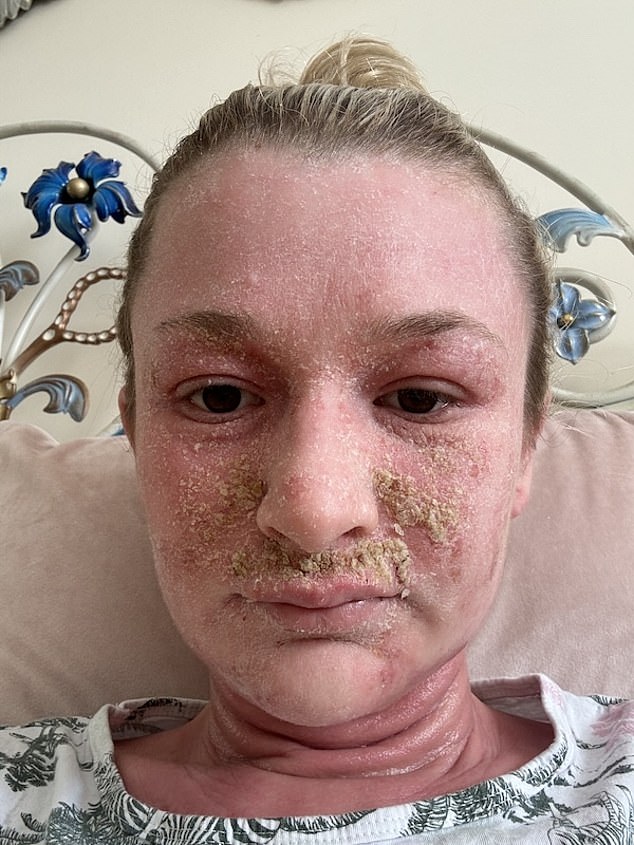
‘The raw skin on my face, limbs and body was breaking down, weeping and peeling,’ says Chloe Tatton, who was experiencing topical steroid withdrawal (TSW), which can occur after people stop taking corticosteroid creams after prolonged use
‘TSW tends to happen in people who have used moderate or strong steroid creams over several years and then stop,’ says Dr Ellie Rashid, a consultant dermatologist at the private OneWelbeck clinic.
‘We don’t fully understand why it happens, but in some cases, when potent topical steroids are stopped suddenly after long-term use, it can trigger a rebound effect, weakening the skin barrier. The immune system becomes overactive leading to rebound inflammation.’
She adds: ‘TSW is not just a flare-up of the skin condition. Changes have been found in skin cells and the mitochondria – essentially the battery in every cell, which produces energy – that point to a different biological process.’
The DNA in the mitochondria carry ‘instructions’ to produce energy.
‘In TSW, there may be reduced function of this mitochondrial DNA, potentially leading to poor skin repair and persistent inflammation,’ says Dr Rashid.
Chloe, an event management specialist from Cheshire, was three months old when she was first prescribed a steroid cream to treat a small patch of eczema on her cheeks.
Her mother, grateful for a solution, followed the instructions carefully – applying a thin layer once or twice a day.
After that and throughout her childhood and into adulthood, Chloe used topical steroids to control flare-ups every month or so, as prescribed by her GP and dermatologist.
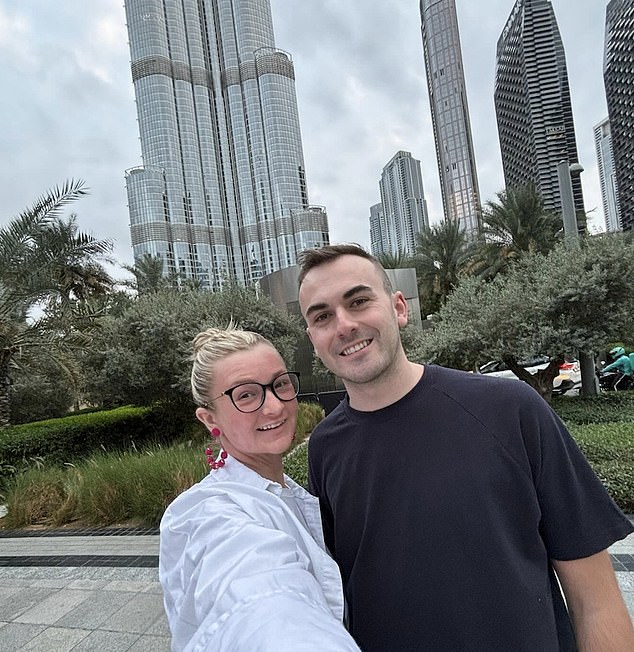
Chloe and her partner Matthew relocated to Dubai last year, hoping the change of climate might help ease her skin problems
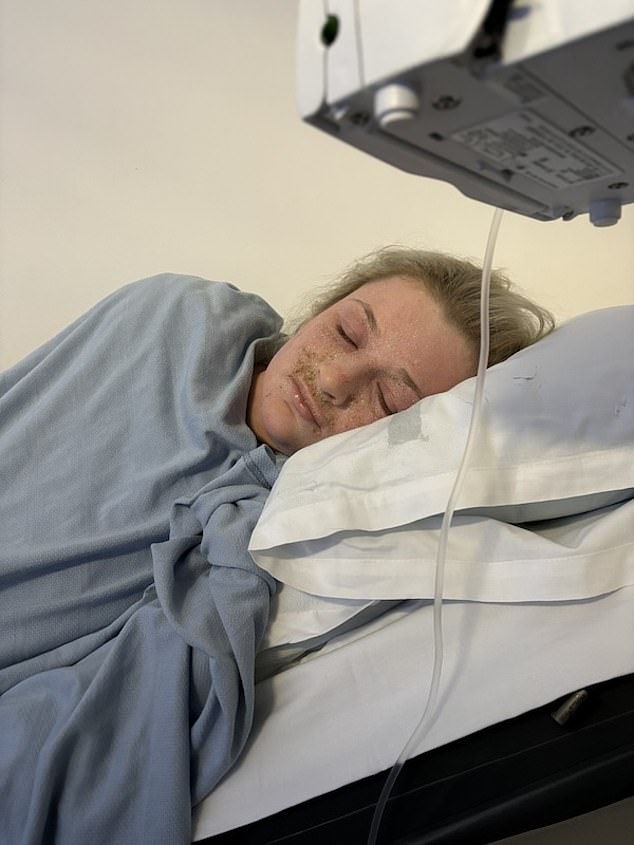
But the move became a medical nightmare, leaving her bedridden and eventually hospitalised with a potentially life-threatening skin condition
Yet, each time she stopped, the eczema would return and seemed to gradually worsen, resulting in having to apply the cream over a larger area, sometimes daily.
‘But never did we imagine that this short-term fix would lead to a long-term problem,’ says Chloe.
‘No one ever explained the risk that my skin could become reliant on the cream – or that coming off it would be a nightmare.’
This reliance on the medication, known as topical steroid dependence, means the patient has to use it continually to maintain the effect – and stopping treatment leads to TSW, explains Dr Rashid.
The problem is that most doctors, even many dermatologists, are not trained to recognise TSW, she adds.
‘Many of the symptoms can look like severe eczema, so it’s often mislabelled as a flare-up.
‘But the symptoms – which can include stinging, redness, flaking, extreme sensitivity and fatigue – are often worse than typical eczema and last for months.’
Professor Celia Moss, a retired consultant dermatologist and a trustee of the National Eczema Society, says some of the confusion about recognising ‘topical steroid withdrawal’ is the term – ‘topical steroid withdrawal reaction is probably a better term’.
Chloe’s TSW problems first started in April 2021, when she woke to find her face swollen and red.
‘I looked like I’d been stung by a bee,’ she recalls. She went to her GP who prescribed another stronger steroid cream and referred her to a dermatologist.
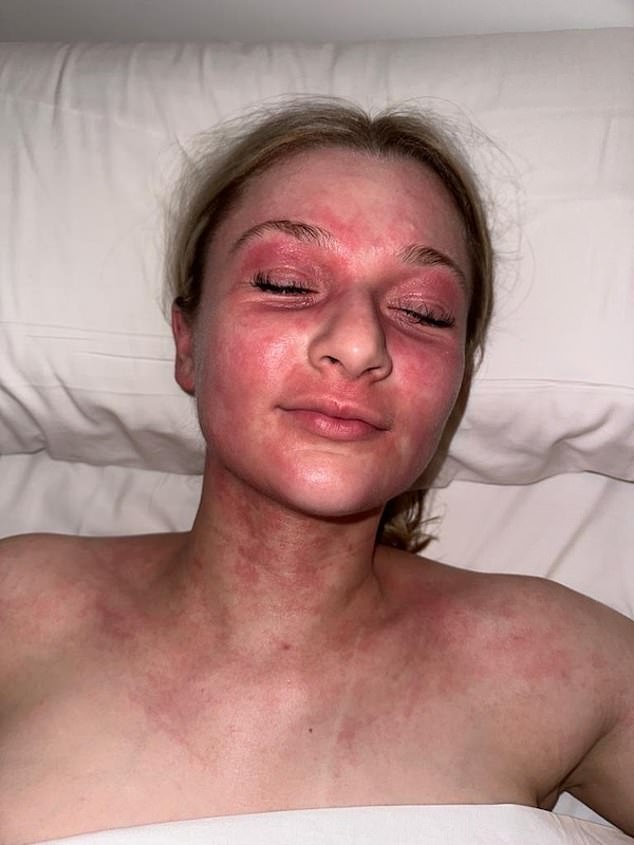
During the ten-hour flight to Dubai, the skin on Chloe’s face erupted. ‘I was in agony,’ she says. ‘When I got off the plane, people were staring at my bright red face’
In 2021, Chloe underwent a range of treatments, including phototherapy, which uses light to re-duce inflammation and itching; immunosuppressant medicine to calm her immune system; and different steroid creams. But her skin symptoms were getting progressively worse.
Doing her own research, Chloe discovered TSW. But when she raised the concern with her dermatologist, she was told she simply had ‘extreme eczema’.
Chloe knew otherwise, she says: ‘I’d had eczema all my life, this was different. I had intense burning skin and widespread redness in places where I had never used steroids.’
In September 2023, after 23 years of regular steroid use, Chloe – realising they were only damaging her skin further – stopped using the creams.
By the following week, her skin had started to completely break down, weeping and peeling.
At her next appointment, the dermatologist suggested starting a new treatment, Dupixent (a brand name of Dupilumab), given by an injection – a new type of drug known as a monoclonal antibody, which works by targeting proteins that trigger inflammation.
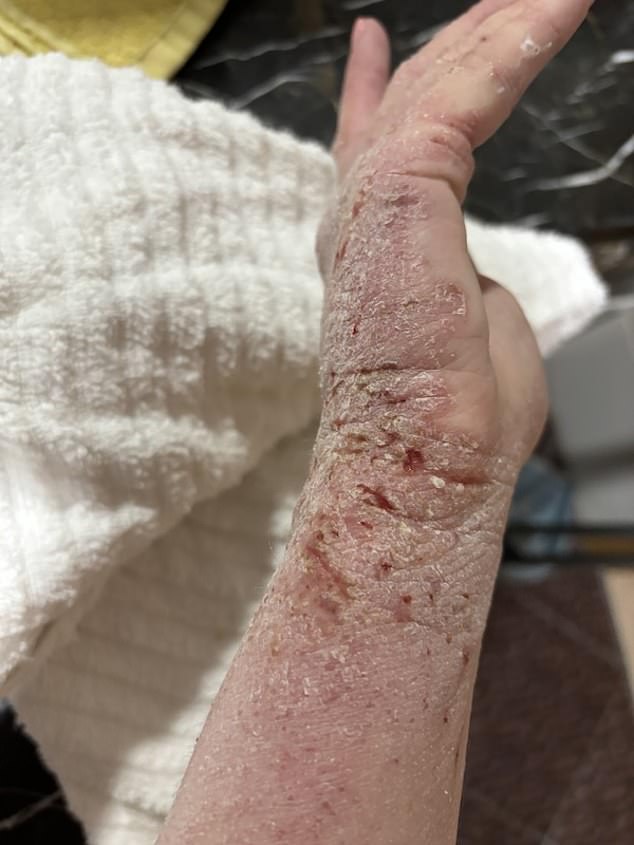
After 23 years of regular steroid use, Chloe – realising they were only damaging her skin further – stopped using the creams. By the following week, her skin had started to completely break down, weeping and peeling
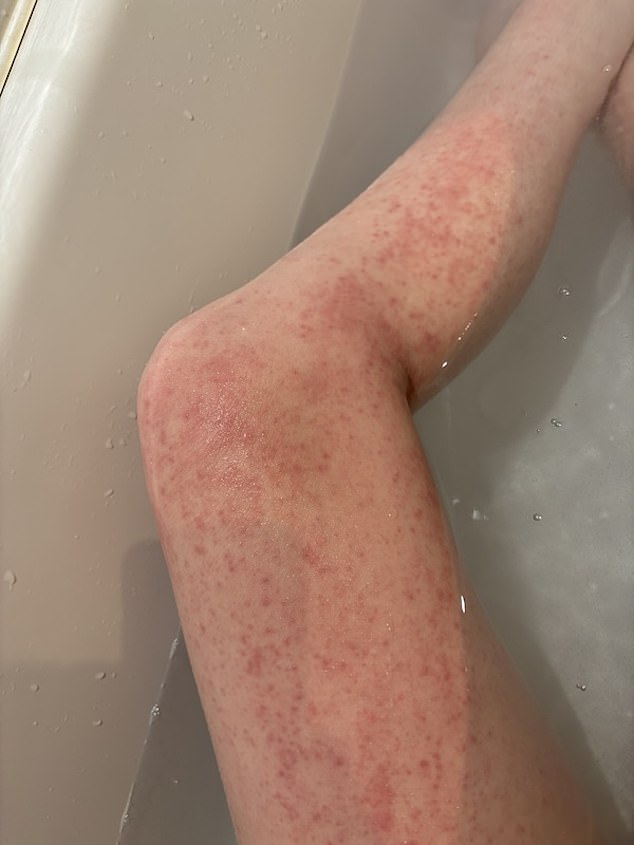
Within weeks of arriving in Dubai, Chloe was bedridden because her whole body was affected, she was unable to work – and was completely reliant on Matthew for round-the-clock care
But before she could begin treatment, Chloe and her partner Matthew decided to move to Dubai.
Even though she was already experiencing TSW, Chloe was hopeful that the warmer climate would help her skin. But during the ten-hour flight, the skin on her face erupted.
‘I was in agony,’ she says. ‘When I got off the plane, people were staring at my bright red face.’
Within weeks of arriving, she was bedridden because her whole body was affected, she was unable to work – and was completely reliant on Matthew for round-the-clock care.
‘He was cooking, cleaning, bandaging my skin and running salt baths which had helped at home,’ she says. ‘He never once made me feel ugly or unlovable.’
Chloe also started experiencing nerve pain, severe itching, insomnia and depression.
In March 2024, it was decided that Chloe should return to the UK for treatment.
‘It was the hardest decision,’ she says. ‘Matthew stayed for work and we’re maintaining a long-distance relationship.’
Back home, Chloe’s condition deteriorated – ‘I was feverish, confused and my skin was burning up: Mum thought I had sepsis,’ she recalls.
At the local hospital, doctors diagnosed erythroderma, a potentially fatal condition where more than 90 per cent of the skin becomes inflamed – it can be triggered by the withdrawal of corticosteroids. Chloe had to be stabilised with fluids and antibiotics.
Then, finally, in June last year, she was approved for Dupixent on the NHS, which required approval by multiple dermatologists and the local health authority.
The drug is expensive – £1,264.89 for a two-pack of prefilled syringes: she now injects herself with one every two to three weeks.
Chloe says: ‘My skin is a million times better. I’m finally living my life again.’
While Dupixent is helping patients like Chloe, ‘many GPs can’t or won’t prescribe anything for eczema other than topical steroids’, says Professor Moss.
However, people should not fear using steroid treatments, she adds: ‘Millions of patients and numerous conditions have been safely treated with topical steroids over the last 70 years.’
The key is not to stop using them abruptly.
‘There’s bound to be flare-ups when the immunosuppressive effect of the topical steroid is suddenly removed. So patients should generally be weaned off gradually and offered alternative treatment.’
Fortunately, there seems to be greater awareness of TSW, thanks to patients themselves.
‘Until recently, TSW wasn’t seen as a separate condition, so it wasn’t being studied properly – it’s only now that patients’ experiences are starting to drive research forward,’ says Dr Rashid. ‘Their stories have brought TSW into the spotlight and made it impossible to ignore, showing just how serious it can be, not just physically but emotionally.’
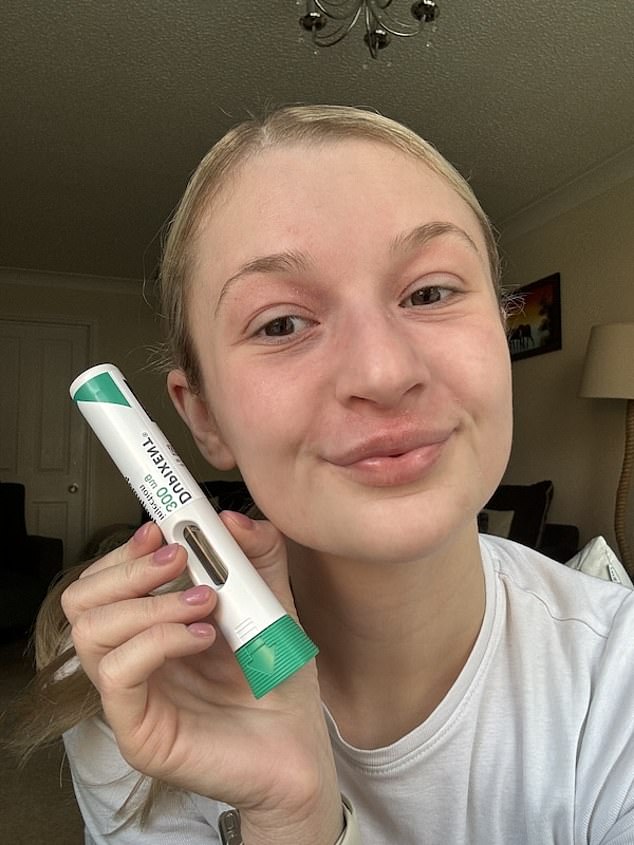
In June last year, Chloe started applying Dupixent. The drug is expensive – £1,264.89 for a two-pack of prefilled syringes: she now injects herself with one every two to three weeks

Chloe now says: ‘My skin is a million times better. I’m finally living my life again’
‘We’re at a turning point,’ she adds. She points to the National Eczema Society acknowledging TSW as a complication of stopping using topical steroids, and its calls for urgent research on how it differs from eczema and the criteria for diagnosing it. ‘
Professor Moss agrees there are signs of progress: ‘The Medicines and Healthcare products Regulatory Agency has recently published information about TSW for patients and prescribers – and the National Eczema Society now has information and FAQs on its website.
‘Plus, the British Association of Dermatologists has set up a TSW working group to review the evidence and establish guidelines. There is also more awareness of the mental health issues caused by skin disease.’
This is something that has affected Chloe, who last September received counselling and cognitive behavioural therapy (CBT) to manage her anxiety after her experience.
‘I still panic about TSW flare-ups,’ she says. ‘Even wearing make-up or eating the wrong thing can trigger a skin reaction.’
Chloe believes patients deserve to be better informed.
‘Right now, we’re handed prescriptions without being told the risks,’ she says. ‘And if my story can help one person question a prescription or feel less alone, then it’s worth telling.’












